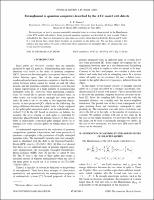Please use this identifier to cite or link to this item:
https://hdl.handle.net/20.500.12202/4285Full metadata record
| DC Field | Value | Language |
|---|---|---|
| dc.contributor.author | Santos, Lea F. | - |
| dc.date.accessioned | 2018-12-26T21:21:48Z | - |
| dc.date.available | 2018-12-26T21:21:48Z | - |
| dc.date.issued | 2003-06 | - |
| dc.identifier.citation | Santos, L.F. (2003). Entanglement in quantum computers described by the XXZ model with defects. Physical Review A | en_US |
| dc.identifier.issn | 0031-899X | - |
| dc.identifier.uri | https://doi.org/10.1103/PhysRevA.67.062306 | en_US |
| dc.identifier.uri | https://hdl.handle.net/20.500.12202/4285 | - |
| dc.description.abstract | We investigate on how to generate maximally entangled states in systems characterized by the Hamiltonian of the XXZ model with defects. Some proposed quantum computers are described by such a model. Defects embedded in this otherwise homogeneous spin chain are used to obtain Einstein-Podolsky-Rosen and W states. It is well known that a large defect localizes an excitation on the defect site. We can then consider a few identical and large defects to create a subsystem whose eigenstates are entangled. Here, we examine the cases of one and two excitations. | en_US |
| dc.language.iso | en_US | en_US |
| dc.publisher | American Physical Society | en_US |
| dc.relation.ispartofseries | Physical Review A; | - |
| dc.rights | Attribution-NonCommercial-NoDerivs 3.0 United States | * |
| dc.rights.uri | http://creativecommons.org/licenses/by-nc-nd/3.0/us/ | * |
| dc.subject | entanglement | en_US |
| dc.subject | quantum computers | en_US |
| dc.subject | XXZ model | en_US |
| dc.title | Entanglement in quantum computers described by the XXZ model with defects. | en_US |
| dc.type | Article | en_US |
| dc.contributor.orcid | 0000-0001-9400-2709 | |
| local.yu.facultypage | https://www.yu.edu/faculty/pages/santos-lea | |
| Appears in Collections: | Stern College for Women -- Faculty Publications | |
Files in This Item:
| File | Description | Size | Format | |
|---|---|---|---|---|
| Santos Entanglement PhysRevA.67.062306.pdf | OA | 52.84 kB | Adobe PDF |  View/Open |
This item is licensed under a Creative Commons License

